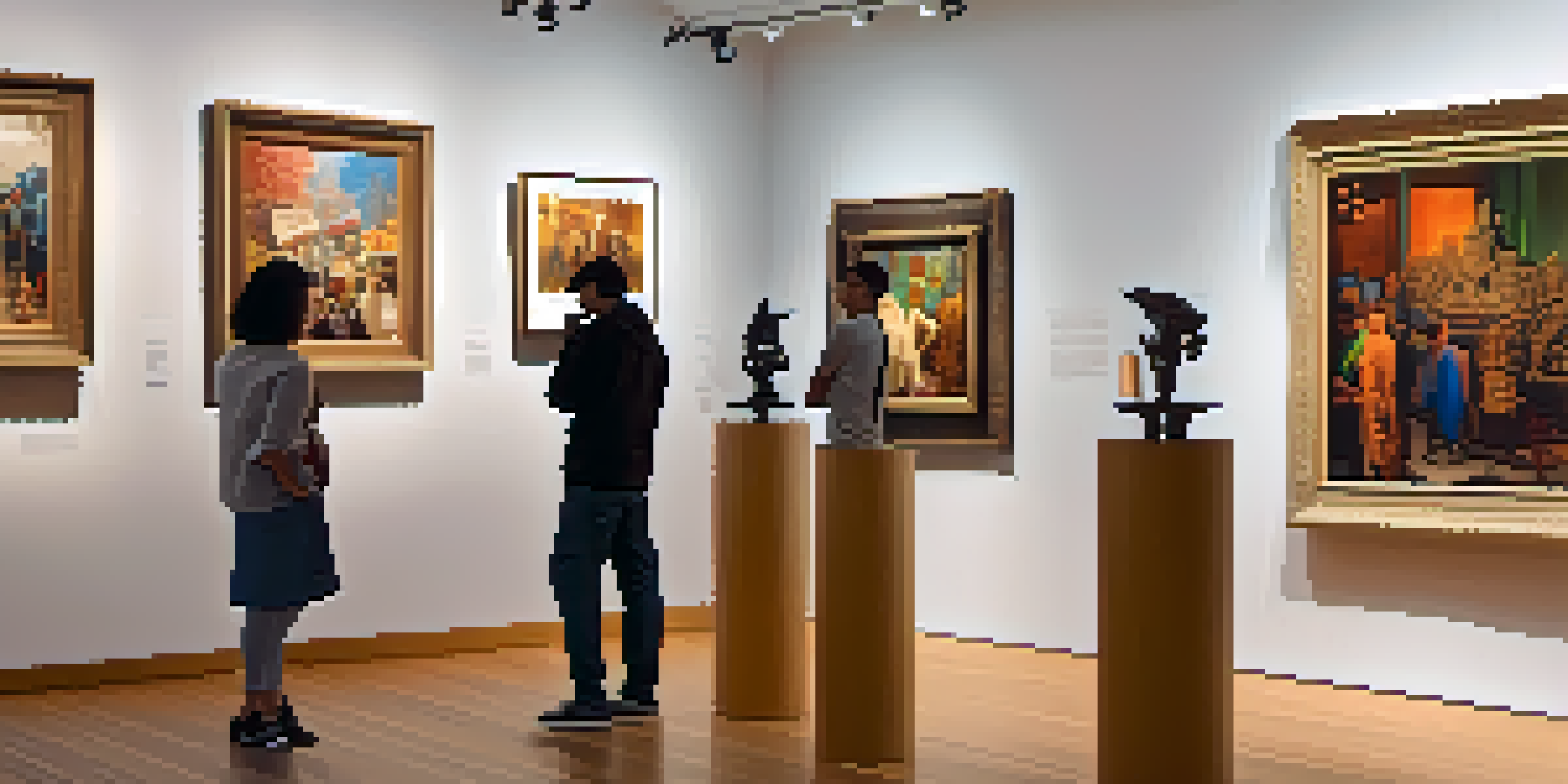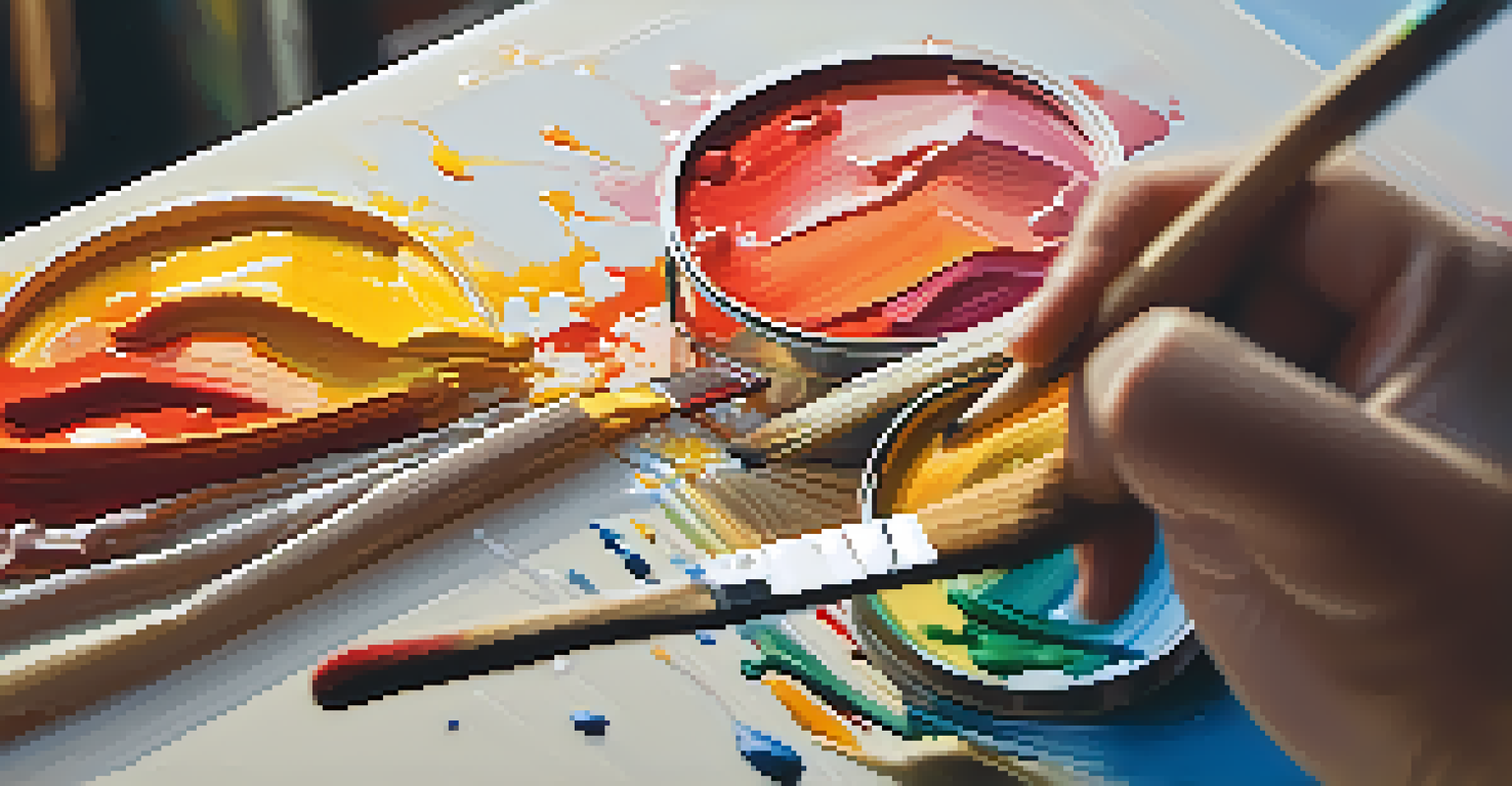Art Criticism in the Digital Age: New Methods Emerging

The Evolution of Art Criticism in a Digital Landscape
Art criticism has undergone a significant transformation with the rise of digital platforms. Gone are the days when critiques were confined to print media; now, artists and audiences can engage in real-time discussions online. This shift has democratized art criticism, allowing diverse voices to contribute and share their perspectives. As a result, the landscape of art evaluation is becoming more inclusive, reflecting a broader spectrum of experiences and interpretations.
Art is a lie that makes us realize truth.
The advent of social media has particularly impacted how art is critiqued and discussed. Platforms like Instagram and Twitter enable artists to showcase their work and receive immediate feedback from a global audience. This instant interaction fosters a sense of community and collaboration, where opinions can be shared widely and quickly, often leading to viral trends in both art and criticism. It’s not just about sharing art anymore; it’s about creating a dialogue around it.
However, this accessibility also raises questions about the quality of criticism. With so many voices chiming in, distinguishing between informed critique and casual opinion can be challenging. As art critics navigate this new landscape, they must adapt their methods, ensuring that their insights remain valuable and relevant amid the noise of the digital world.
The Role of Social Media in Art Criticism
Social media platforms have revolutionized how we engage with art and its critique. Artists now utilize these channels not just to showcase their work but also to connect with audiences and critics alike. This direct line of communication allows for a more nuanced understanding of the artist's intent and the context behind their work. In this space, every post can spark discussions and debates that were once limited to gallery openings and art reviews.

Moreover, social media has enabled a new form of art criticism that is more visual and immediate. Critics can share images, videos, and live critiques that resonate with audiences on a personal level. This shift towards a more dynamic form of criticism fosters engagement and encourages viewers to think critically about what they see. It’s a refreshing change from traditional text-heavy reviews, making art more accessible to those who might find written critiques daunting.
Digital Platforms Democratize Critique
The rise of digital platforms has transformed art criticism by enabling real-time discussions and making diverse voices more accessible.
However, while social media has its advantages, it also presents challenges. The fast-paced nature of these platforms can lead to superficial critiques that prioritize likes and shares over depth and analysis. Critics must strike a delicate balance between being engaging and providing thoughtful, substantive commentary that enhances the audience's understanding of the art.
Emerging Technologies Shaping Art Criticism
Technological advancements are not only changing how art is created but also how it is critiqued. Virtual reality (VR) and augmented reality (AR) are beginning to play significant roles in art criticism by offering immersive experiences. Critics can explore art installations in virtual spaces, providing a richer context for their reviews. This technology allows for a more holistic understanding of the artwork, considering elements that may not be apparent in a traditional viewing.
The role of the artist is to make the world a better place, to express the ineffable, and to connect with others through dialogue.
Furthermore, artificial intelligence (AI) is beginning to influence the analytical aspects of art criticism. With algorithms that can analyze patterns, styles, and historical context, AI can assist critics in drawing comparisons and insights that might be overlooked. This data-driven approach can enhance traditional critique methods, providing a more comprehensive evaluation of art pieces. However, the human element of empathy and intuition in criticism remains irreplaceable.
As these technologies continue to evolve, they promise to revolutionize the landscape of art criticism even further. Critics will need to adapt to these changes, learning how to incorporate new tools into their analysis while maintaining the vital human touch that makes art criticism resonate. The future of art critique lies in this intersection of technology and personal insight.
The Importance of Diverse Perspectives in Critique
Diversity in art criticism is more crucial than ever, particularly in our interconnected world. Different cultural backgrounds and experiences can significantly shape how art is interpreted and critiqued. By embracing a variety of voices, the art community can foster richer discussions that reflect the complexity of contemporary issues. This approach not only benefits critics but also artists who can gain new insights into their work.
Digital platforms facilitate this inclusivity, allowing marginalized voices to be heard. Critics from various backgrounds can share their perspectives, challenging the dominant narratives that have historically shaped art discourse. This shift is essential in promoting a more equitable art world, where everyone has the opportunity to contribute to the conversation. The result is a more vibrant and dynamic critique landscape that acknowledges and celebrates diversity.
Emerging Tech Enhances Critique
Technological innovations like VR, AR, and AI are reshaping art criticism, allowing for immersive experiences and data-driven insights.
As we move forward, it is vital for critics to actively seek out and amplify underrepresented voices in the art community. By doing so, we can create a culture of critique that is not only comprehensive but also reflective of the diverse world we inhabit. This commitment to inclusion will enrich our understanding of art and its myriad interpretations.
Navigating the Challenges of Online Criticism
While the digital age has opened doors for more voices in art criticism, it also comes with its fair share of challenges. Online platforms can sometimes foster negativity, with trolls and harsh feedback overshadowing constructive criticism. Critics must navigate this landscape carefully, ensuring their commentary remains respectful and insightful, even in the face of adversity. Building a supportive community around criticism can help mitigate the effects of negativity.
Moreover, the fast-paced nature of online discourse can lead to misunderstandings and misinterpretations of an artist's work. Critics must take extra care to provide context and clarity in their critiques, avoiding snap judgments that can misrepresent the art. This diligence is crucial in maintaining the integrity of the critique process, ensuring that artists feel valued and understood.
Ultimately, navigating these challenges requires a balance of honesty and empathy. Critics should strive to foster healthy discussions that encourage growth and understanding, both for themselves and the artists they critique. By approaching online criticism with a thoughtful mindset, we can create a more positive environment for artistic expression.
The Future of Art Criticism: Trends to Watch
Looking ahead, several trends are poised to shape the future of art criticism in the digital age. One significant trend is the rise of collaborative criticism, where multiple voices come together to analyze and discuss artworks. This approach not only enriches the critique but also reflects the collaborative nature of contemporary art practices. As artists increasingly work in teams, it makes sense for critics to adopt a similar model.
Another trend is the integration of multimedia elements into criticism. As audiences grow accustomed to engaging with content in various formats, critics will likely expand their methods beyond traditional writing. Expect to see more video essays, podcasts, and interactive critiques that invite viewers to participate in the conversation. This multimedia approach can make art criticism more engaging and accessible to a broader audience.
Diversity is Key in Art Criticism
Embracing diverse perspectives in art critique enriches discussions and promotes a more equitable art community.
Finally, as the digital landscape continues to evolve, so too will the platforms through which art criticism is delivered. Emerging technologies will create new opportunities for critics to share their insights, whether through virtual exhibitions or interactive online forums. The future promises an exciting array of possibilities for how we engage with and critique art, paving the way for innovative and impactful discussions.
Conclusion: Embracing Change in Art Critique
As we navigate the digital age, embracing change in art criticism becomes essential. The methods and platforms may be evolving, but the core purpose of critique remains the same: to foster understanding and appreciation of art. By adapting to new technologies and encouraging diverse voices, we can enrich the dialogue surrounding art and its interpretation. This adaptability will be crucial as we face the challenges and opportunities that lie ahead.
Moreover, embracing these changes allows critics to remain relevant in a rapidly shifting landscape. By being open to new formats, collaborative efforts, and diverse perspectives, critics can engage with audiences in meaningful ways. This connection is vital for the continued growth and evolution of art criticism, ensuring that it remains a vital part of the artistic ecosystem.

In conclusion, the digital age offers exciting possibilities for art criticism. By navigating these changes with a thoughtful and inclusive approach, we can elevate the conversation around art, making it more accessible and engaging for everyone. The future of art criticism is bright, and it’s up to us to embrace it fully.